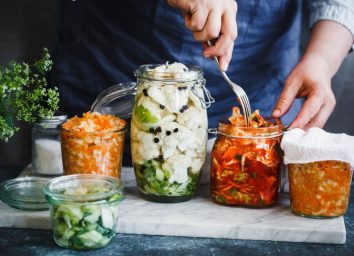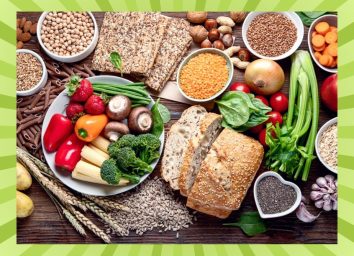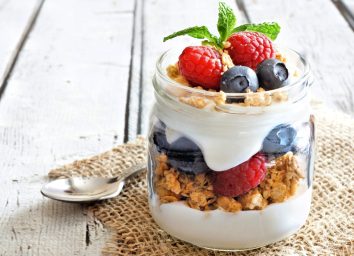What Are Prebiotics? Plus 10 Dietitian-Approved Ways to Get More
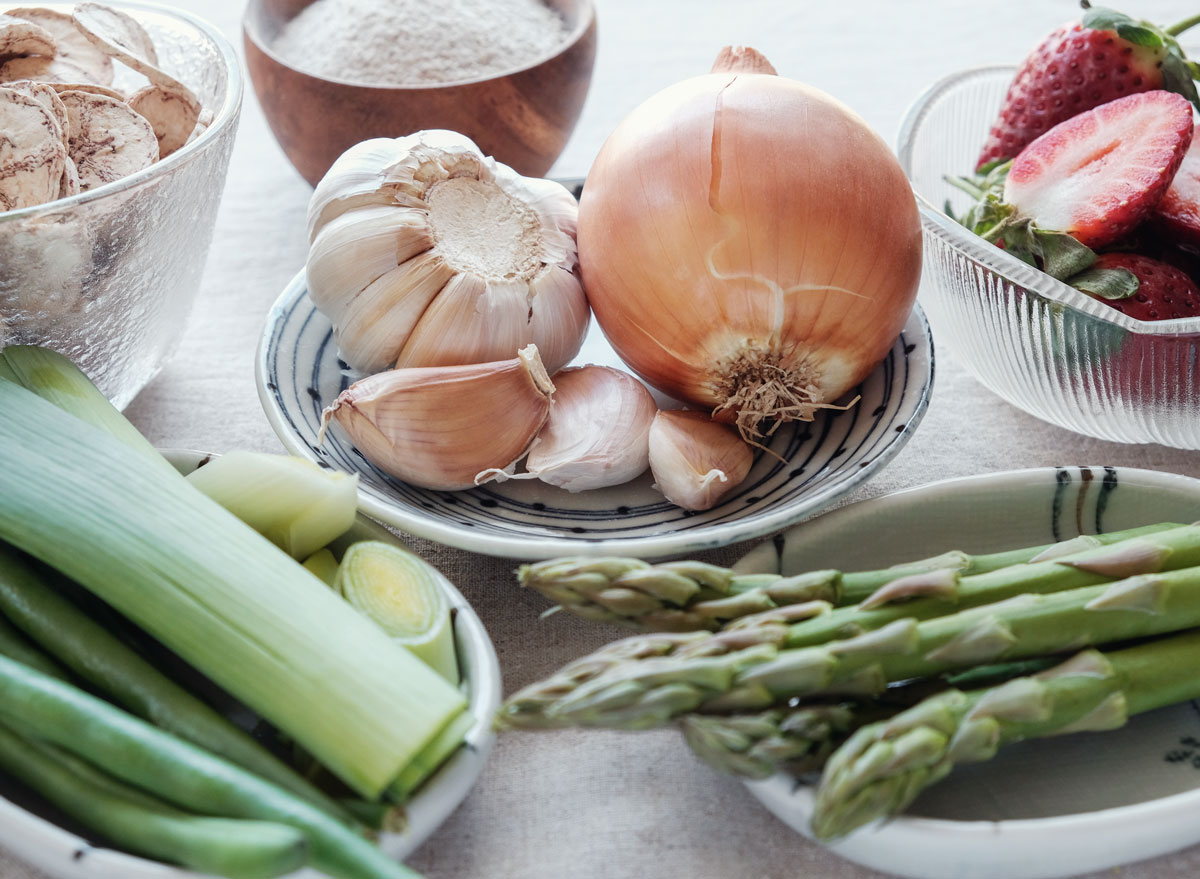
You've heard about how important gut health is, so you've been working extra hard to get probiotics into your diet. You drink kefir and kombucha, eat sauerkraut and kimchi, and take probiotic supplements to nourish a healthy gut microbiome. But did you know that there's an equally, if not more, important way you can immediately take action to improve your gut health? Enter, prebiotics: the new "it girl" in the gut world.
What are prebiotics?
Prebiotics are a class of dietary fibers found in some (but not all) fiber-rich foods like fruits, veggies, and whole grains. They act as the fertilizer and nourishment for all of the good bacteria (probiotics) in your gut. Prebiotics are technically defined as "substrates that serve as nutrients for beneficial microorganisms in a host."
Prebiotic fiber is different from other dietary fibers, such as cellulose, in that these other dietary fibers encourage the growth of a wide variety of gut microorganisms, whereas prebiotics only support the health-promoting ones.
Like all fiber, your body doesn't digest prebiotics. Instead, they go to your colon—and that's where the magic happens. In the colon, they're fermented and good bacteria feast on them, ultimately providing a vast array of prebiotic benefits that include:
- Improving digestive health
- Fighting chronic inflammation and disease
- Boosting immunity
- Possibly helping with satiety
- Helping you manage weight
How are prebiotics different from probiotics?
Probiotics and prebiotics are both important for gut health but for different reasons.
- Probiotics are the "good" live bacteria that exist naturally in your gut. You can also ingest probiotic cultures through certain probiotic foods.
- Prebiotics are the food for probiotics. Think of it this way: if you don't feed the good bacteria what they need to survive, they won't! Without prebiotics, bad bacteria are like robbers without police enforcement: they can take over the good bacteria and wreak havoc on your microbiome. By munching on prebiotic foods, you have the ability to change your gut composition and the function of your gut microbiota for the best.
What foods contain prebiotics?
Chances are you're already eating some prebiotic-rich foods, which is great! And with a few additions, you can help the bacteria population in your gut become a more efficient community. According to Kara Landau, Prebiotic Expert Dietitian and Founder at Uplift Food, you can support bacterial diversity by including prebiotic soluble fibers, resistant starches, and some polyphenolic compounds.
Here's the rundown of the three types of prebiotic foods: soluble fibers, resistant starches, and polyphenols.
1. Soluble fibers
These include the two most investigated prebiotics: inulin‐type fructans and galacto‐oligosaccharides (GOS)— think "GO" for them because when these are a large enough part of the diet, the variety of gut microbes tends to increase. Landau suggests being adventurous by trying Jerusalem artichokes and dandelion greens, as well as eating some more popular, but less dense, prebiotic sources like onion and garlic.
Examples of prebiotic soluble fiber foods include:
- Asparagus
- Bananas (ripe)
- Bran
- Chicory Root
- Dandelion Greens
- Fennel Bulb
- Garlic
- Jerusalem Artichokes (also known as Sunchokes)
- Leeks
- Nuts
- Onions
- Pulses (dried beans, lentils, split peas and chickpeas)
- Savoy Cabbage
- Seeds
- Shallots
2. Resistant starches
If hangry is your middle name, eat more resistant starches. These prebiotics may be especially great for helping with satiety. Landau says that these starches resist digestion and make their way into the gut where they cherry-pick and fuel only the good gut bacteria. Plus, they make cells more responsive to insulin for better blood sugar control.
Examples of prebiotic resistant starch foods include:
- Uncooked oats
- Cooked and cooled potato
- Grains that are cooked, and then cooled (pastas, oats)
- Pulses*
- Seaweed
- Tigernuts
- Unripe bananas
- Unripe green banana flour
- Unmodified potato starch
*Pulses contain soluble fiber and resistant starch: a double-punch of benefits for health-promoting gut microbes.
3. Polyphenols
These are the newest prebiotic kids on the block when it comes to gut health research. Polyphenols are showing the potential to nurture the gut microbiome in addition to their known ability to fight against inflammation and reduce the risk of cardiovascular disease.
- Berries
- Citrus Peels
- Cherries
- Coffee
- Kiwi
- Tea
- Walnuts
How to find prebiotics on food labels.
Reading food labels? Scan for any of the foods above or the words below to signify that you'll be getting prebiotics:
- Acacia gum
- Arabinose
- Fructooligosaccharides
- Galactooligosaccharides
- Inulin
- Lactulose
- Maltodextrin
- Wheat dextrin
What to keep in mind when eating more prebiotic foods.
When it comes to choosing which prebiotics to eat, consuming just one would be like having a flower garden with many different types of flowers and only watering the daisies. If you don't want the roses and lilies to die, you've gotta make sure you spread the love and nourish them all.
Here are 10 ways to eat more prebiotics.
To make sure you're eating a variety of prebiotic foods, we've put together some of our favorite prebiotic recipes and ways to eat more prebiotic foods.
1. Eat last night leftovers straight from the fridge.
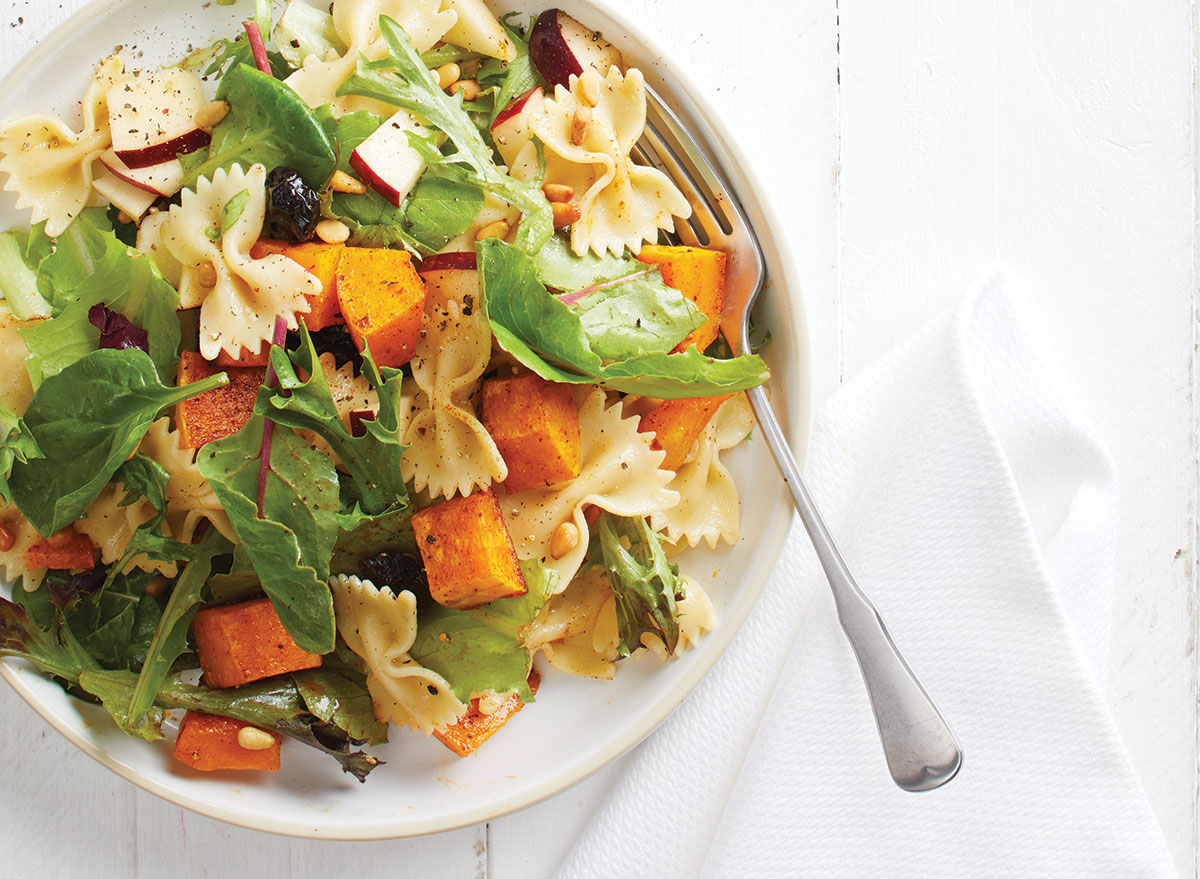
Prebiotics featured: Cold rice, pasta, and potatoes
If you're a fan of eating cold leftovers from Chinese takeout like Chicken, Broccoli, and Rice, or yesterday's chilled pasta or potato salad, a "prebiotic" cheers to you. Cold grains are full of resistant starch, which you don't absorb. Translation: Indulge in these carbs, nourish the good bacteria in your gut and at the same time, your waistline will take less of a hit because you don't absorb some of the carbs and calories. Sign us up!
Not a fan of refrigerated leftovers? Try any of these prebiotic recipes from scratch:
- Butternut Squash Pasta Salad Recipe (pictured)
- Chickpea Cold Pasta Salad Recipe
- Tri-Colored Pepper Potato Salad Recipe
- Indian Spiced Potato Salad Recipe
2. Sip on soup.
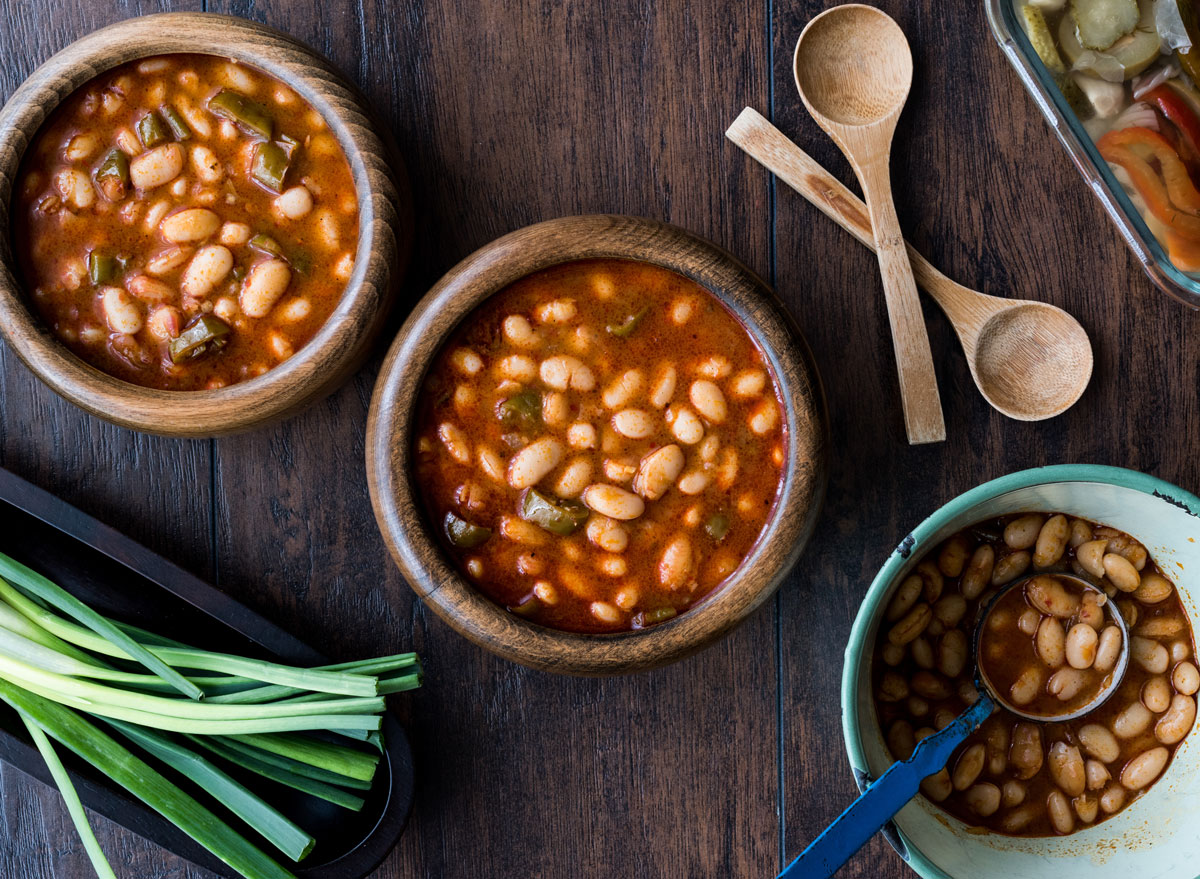
Prebiotics featured: pulses like black, red and white beans, lentils, garlic, onions, leeks, seeds
Soups are one of the easiest ways to consume more than one prebiotic in a single meal. Add pulses like lentils or beans to make a hearty soup with plant-based protein and to reap the benefits of two kinds of prebiotic fiber since pulses contain both soluble fiber (galacto-oligosaccharides [GOS]) and resistant starch to fuel health-promoting gut microbes. You can also double down on the prebiotic benefits by topping creamy soups with a seasoned seed blend for an added crunch.
Some of our favorite prebiotic soup recipes are:
- Minestrone Soup
- Creamy Cauliflower Soup
- Spicy Pumpkin Chili (Note: it's worth the time and just over a dollar per serving.)
Don't want to cook?
Try this good-for-your-gut Pacific Organic Curry Chickpea Soup made with Chicken Bone Broth featuring prebiotics from lentils, chickpeas, and onions. If you're also looking to lose some LBs, credit the chickpeas and lentils for preventing you from absorbing all of the calories in your meal, thanks to their resistant starch. This soup's also got turmeric and black pepper and early research shows this may be a nod for your healthy gut microbe biodiversity, as well.
3. Dine on sushi.
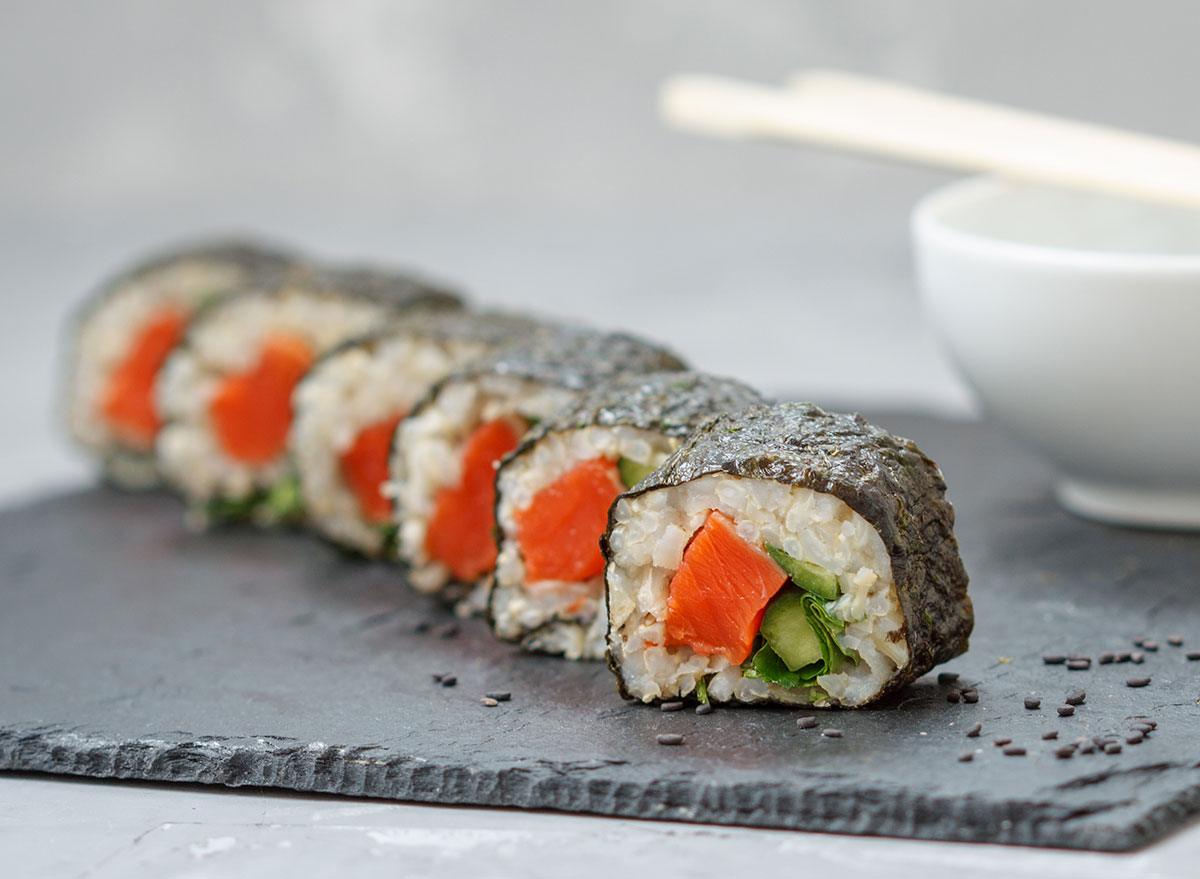
Prebiotics featured: cold rice, seaweed, seeds
If you don't get much resistant starch in your diet, grab your chopsticks. Sushi rice is always served cold, a score for your dose of this prebiotic fiber. And while you may think of seaweed as just a low-carb wrap alternative, its fiber feeds gut bacteria and creates short-chain fatty acids (SCFA). SCFA (which you can remember as "So Cool For All") nurse the cells that line the colon, strengthen the colon's barrier and stop harmful microbes in their track. While the fermentable fiber in seaweed doesn't meet the precise definition for prebiotics, studies do suggest potential health benefits from these SCFAs. Request that your rice be rolled in sesame seeds for an extra prebiotic punch.
Try this sushi recipe to make your own prebiotic snack at home. To prepare sushi even faster, you can purchase prepared rice, like Trader Joe's brown rice, and simply lay down your seaweed sheet, layer with your resistant starch prebiotic-rich rice, sesame seeds and other additions, and roll it up. You can also try these seaweed snacks.
4. Swap meat-based meals for pulses.
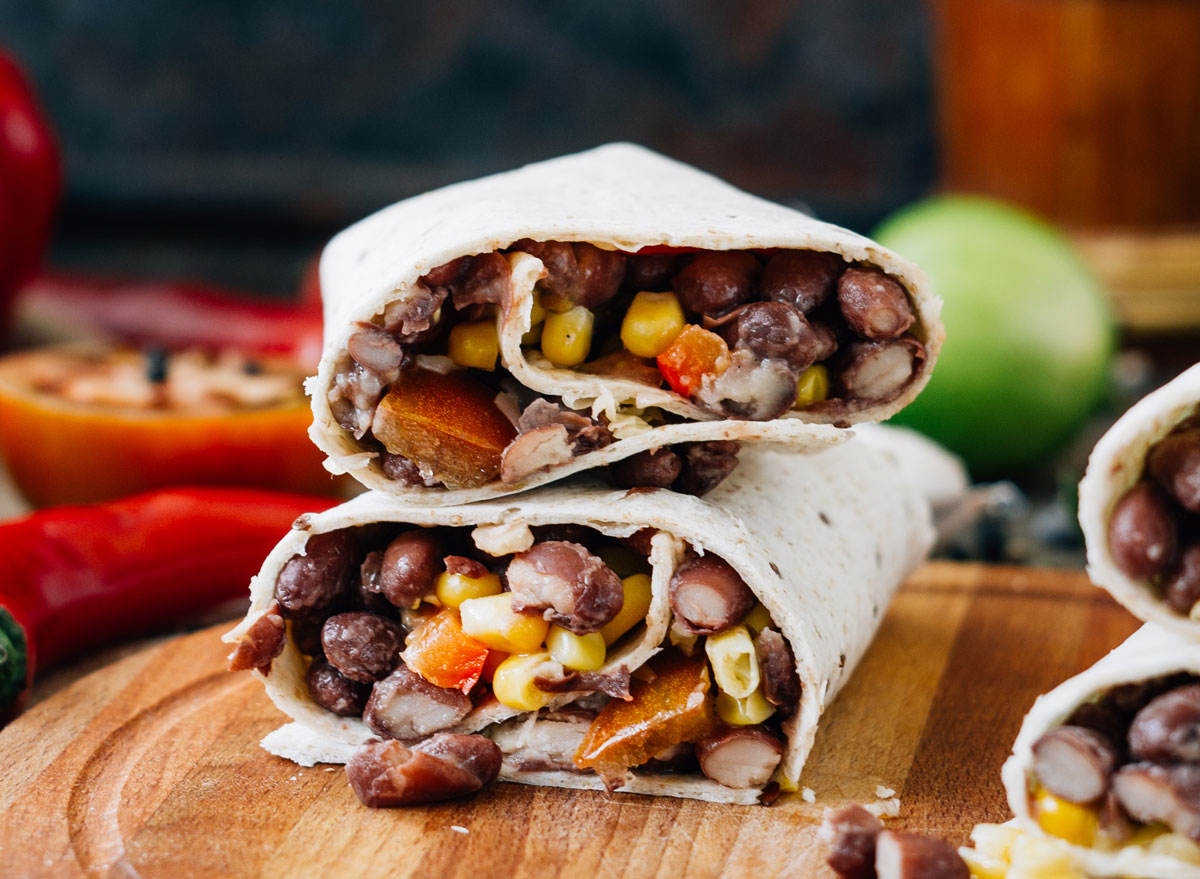
Prebiotics featured: lentils, black beans, garlic, onions
If you're trying to eat more plant-based meals without feeling hungry, replace the meat in your meal for any pulse (chickpeas, lentils, dried beans and split peas). In most recipes, you can simply sub out the meat for the same amount of your uncooked plant-based pulse to get your double belly bonus from pulses' resistant starch and soluble fiber.
Our favorite prebiotic pulse-based recipes are:
- Black Bean Burgers
- Lentil Sloppy Joes
- Lentil Tacos,
- Veggie-Powered Pasta Sauce with Lentils
Looking for a healthy plant-based alternative that's just as quick as a fast-food drive-thru?
Taco Bell Beef Burrito, who? Go for Amy's Light in Sodium Non-Dairy Burritos that are non-GMO and made with organic black beans and rice and that feature prebiotics black beans, garlic, and onion.
5. Eat Muesli.
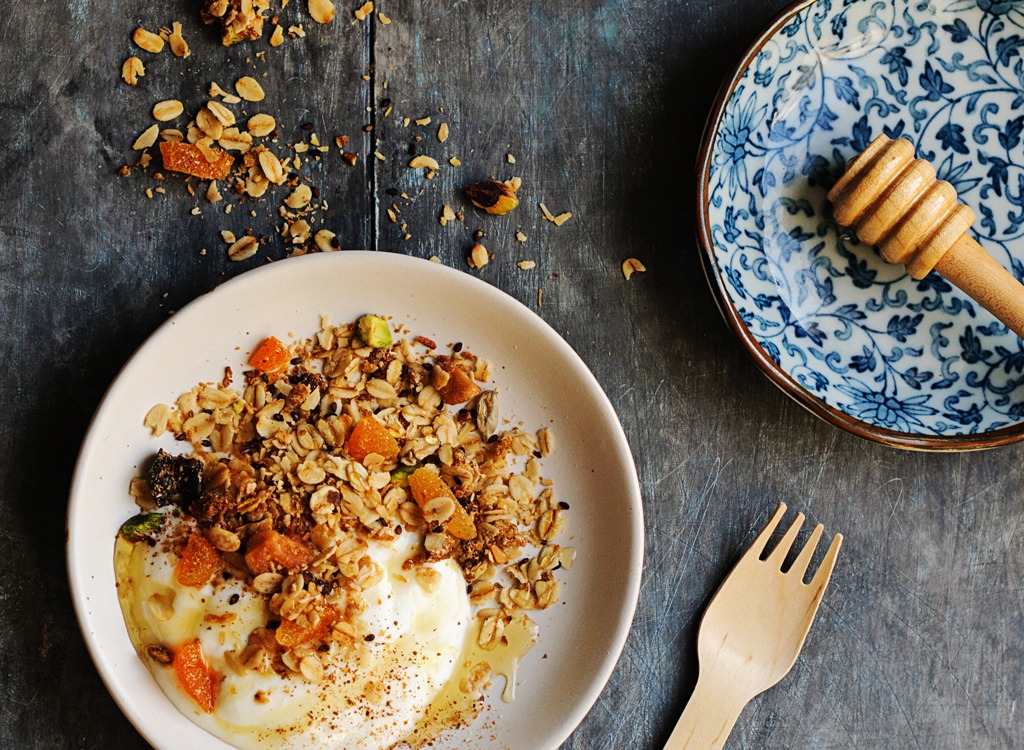
Prebiotics featured: uncooked oats, pistachios, almond butter
If you've drooled over colorful bowls of overnight oats on Instagram and Pinterest, now you've got one more reason to whip up this prebiotic-rich, easy, on-the-go breakfast. Museli is a cereal made with uncooked grains, seeds, nuts, and dried fruit. Pair with probiotic-rich yogurt and your healthy gut will have a field day.
Try some of our favorite recipes:
No time in the morning? You can even buy your muesli.
You reap the most resistant starch benefits from uncooked oats like in Bob's Red Mill Gluten Free Tropical Muesli Cup. The first ingredient is whole grain oats, not a sweetener like many oats cups. In this cup, you also get additional prebiotic fiber benefits from almonds, pumpkin seeds, strawberries, macadamia nuts, and sorghum.
6. Have a prebiotic-rich protein/ energy bar for a snack.
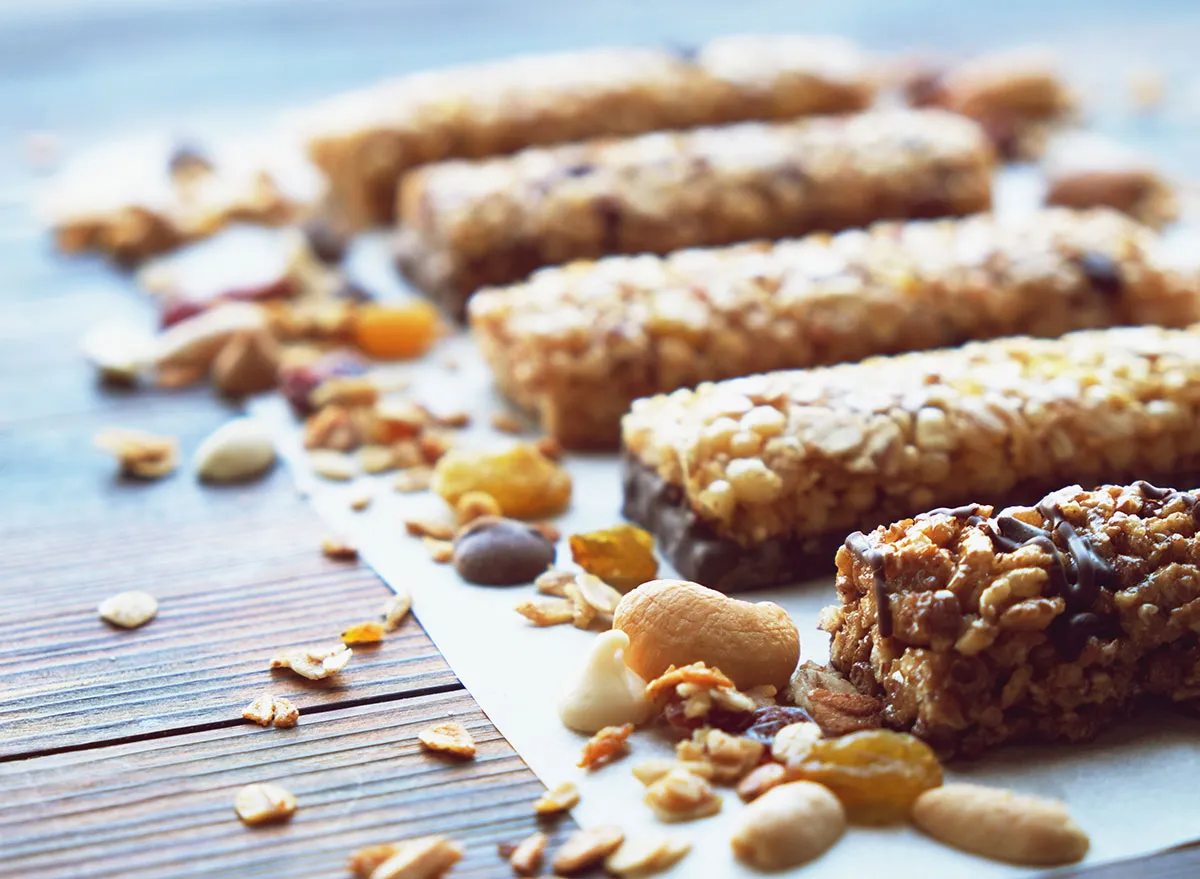
Prebiotics featured: Chicory root, nuts, yacon root
Many energy bars aren't worth the energy it takes to bite them and typically don't do much for your gut health, but if your go-to energy bar lists walnuts, almonds, other nuts and/or seeds, chicory root or yacon root on its' ingredient label, then kudos; you're getting prebiotics!
Choose healthier bars that also pack in belly benefits:
KIND's Dark Chocolate Nuts and Sea Salt bar contains a mix of nutrient-packed, whole almonds and peanuts for prebiotic power. Its' also got chicory root fiber which contains the gut-healthy prebiotic fiber inulin, that's credited for improving gastrointestinal health, as well as heart health, by lowering cholesterol levels. Chicory root has a slight sweetness so less sweetener can be added to the bar. KIND's Dark Chocolate Nuts and Sea Salt bar has only 5 grams of sugar—which is 50% less sugar than the average bar and has no gut-damaging artificial sweeteners or sugar alcohols. Plus, chicory root in this bar may increase feelings of fullness and aid in weight loss. Yesss!
When you see a bar that contains "yacon," that means it contains the yacon root, which comes from South America and has a sweet flavor that actually helps to improve gut health since it's made up of fructooligosaccharides. The Rowdy Bar includes yacon root and almonds, which increase health promoting bifidobacterial. It also contains walnuts, which help you to grow more lactobacillus that can crowd out the bad bacteria and allow the good bacteria to grow. You'll increase the number of butyrate-producing gut bacteria, which means reduced inflammation and a healthier colon!
7. Sip on tasty water infusions.
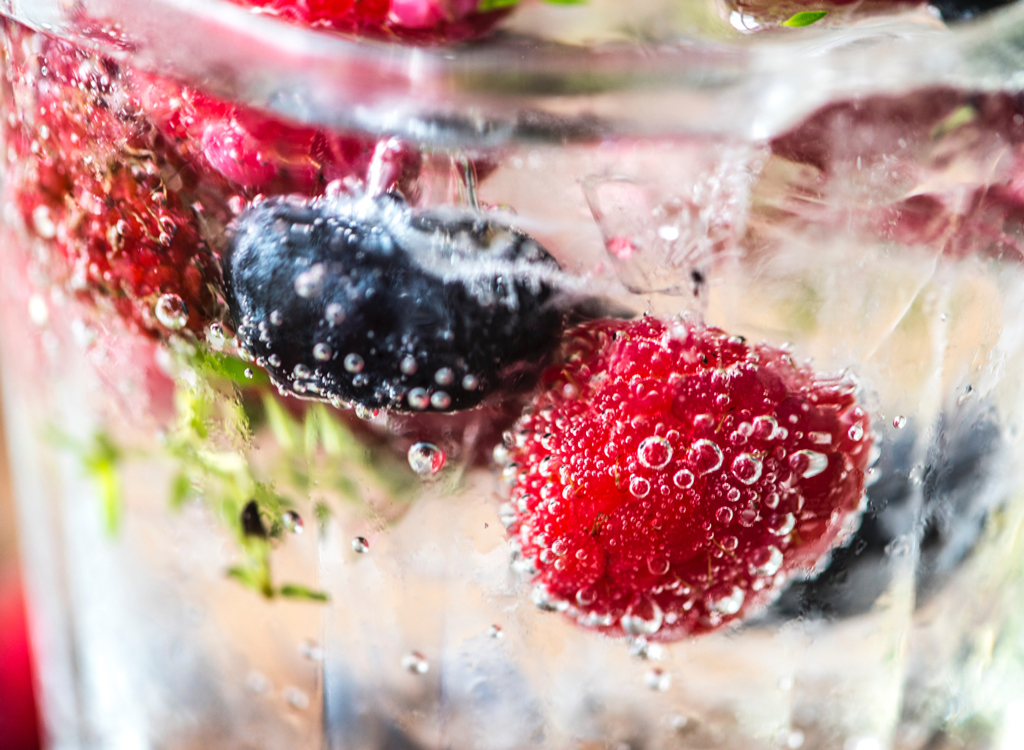
Prebiotics featured: berries, citrus peel, tea
Water infusions can be one of the easiest, most refreshing ways to effortlessly stay hydrated while sipping on prebiotics. Simply add in your favorite citrus and berry fruit combinations and a splash of tea if you'd like, and voila, your taste buds will dance to the beat of polyphenolic prebiotics. Or simply start with green tea and muddle some berries in the side of the glass.
Some of our favorite combinations include:
- Blueberry mint green tea
- Raspberry ginger lime
- Cranberry orange ginger (Note: be sure that you peel the orange roughly, leaving a good deal of the white pith—that's actually pectin, a prebiotic fiber.)
8. Drizzle a little dressing.
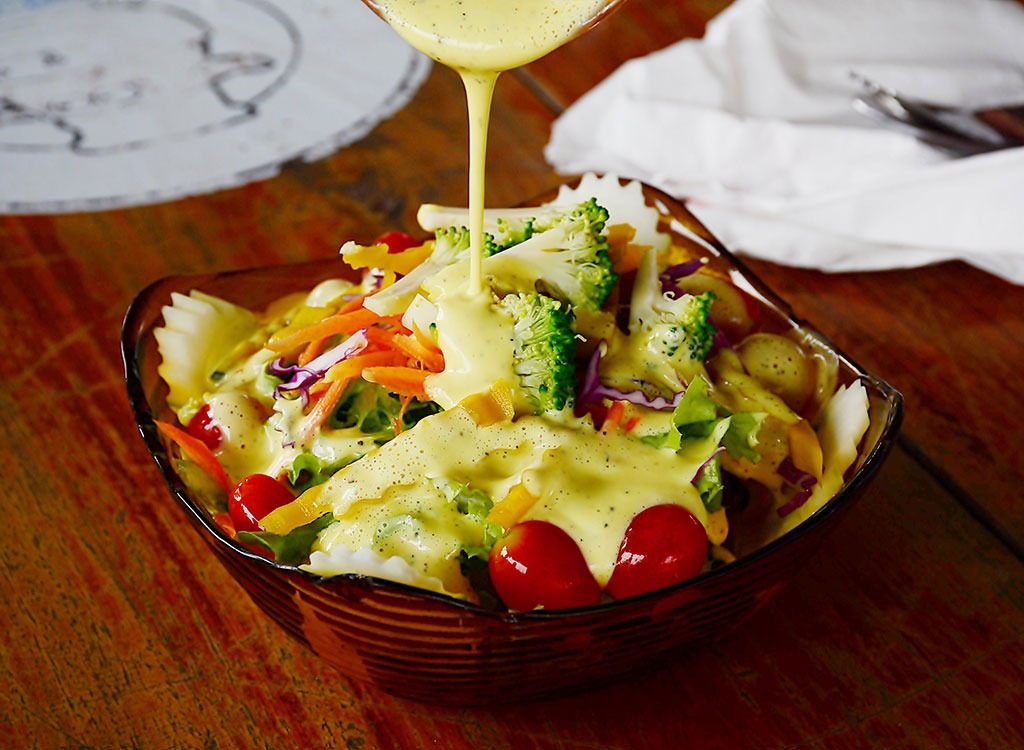
Prebiotics featured: garlic, leeks, onions, spring onions, kiwi, berries
Salad dressings are an easy way to drizzle the prebiotic love since they boost the flavor of other fiber-filled foods to encourage munching. You can make your own by whisking minced onions and garlic into 3 tablespoons of olive oil and 2 tablespoons of vinegar. Add polyphenol prebiotics by muddling berries into the dressing for natural sweetness. (Bonus! Have a dandelion greens salad for an extra prebiotic boost.)
For some prebiotic-rich salad dressing recipes, try:
- Kiwi Dressing Recipe that features prebiotics kiwi and shallots
- Creamy Keto Avocado Dressing that contains prebiotic power from green and yellow onions and garlic.
9. Top your sandwiches, burgers, and salads with raw, fermented foods like kimchi and sauerkraut.
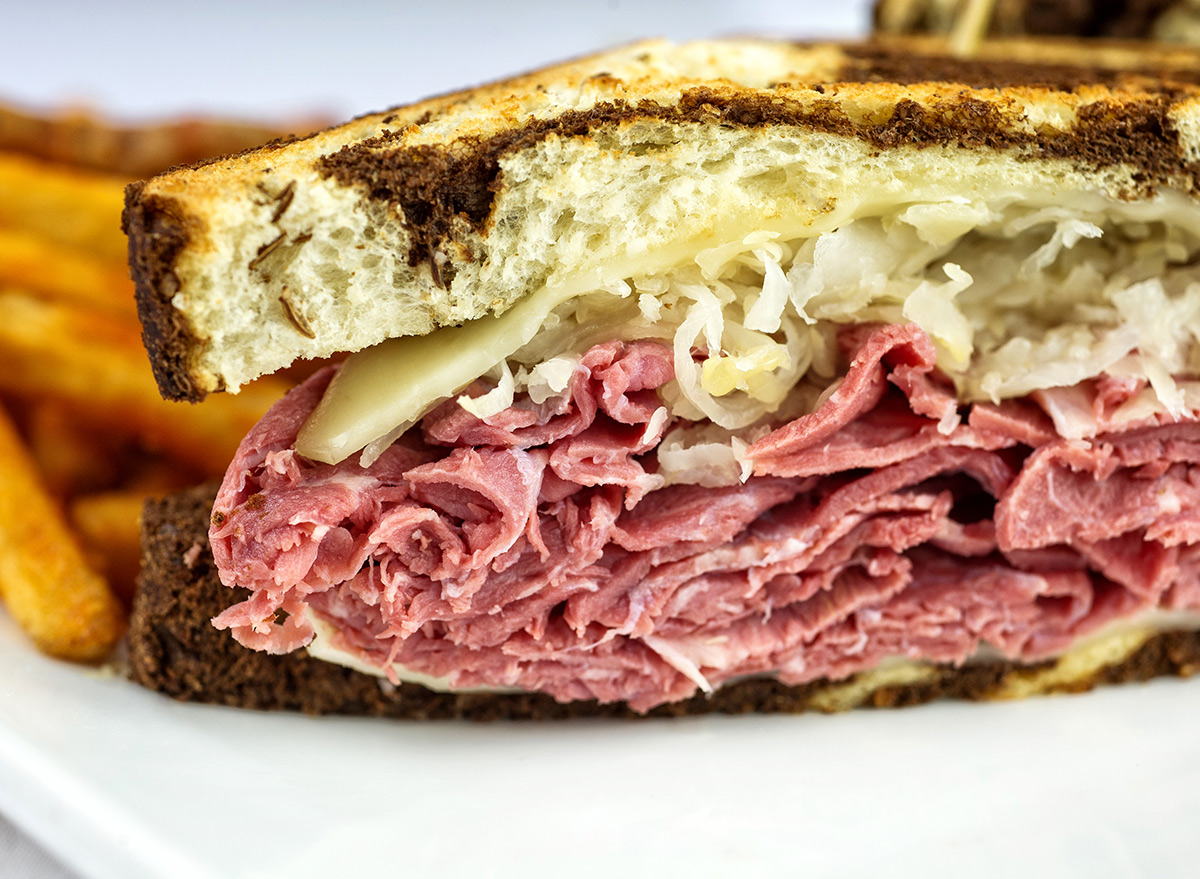
Prebiotics featured: Onions, garlic
We know what you're thinking: these are probiotic foods, not prebiotic-rich foods, but not so fast, speedy! When these include onions and garlic, they are magnifying their power, providing both. Look for versions that include both onions and garlic or make your own with our kimchi recipe.
10. Spread nut butter on toast, an apple or on celery or add it to a smoothie.
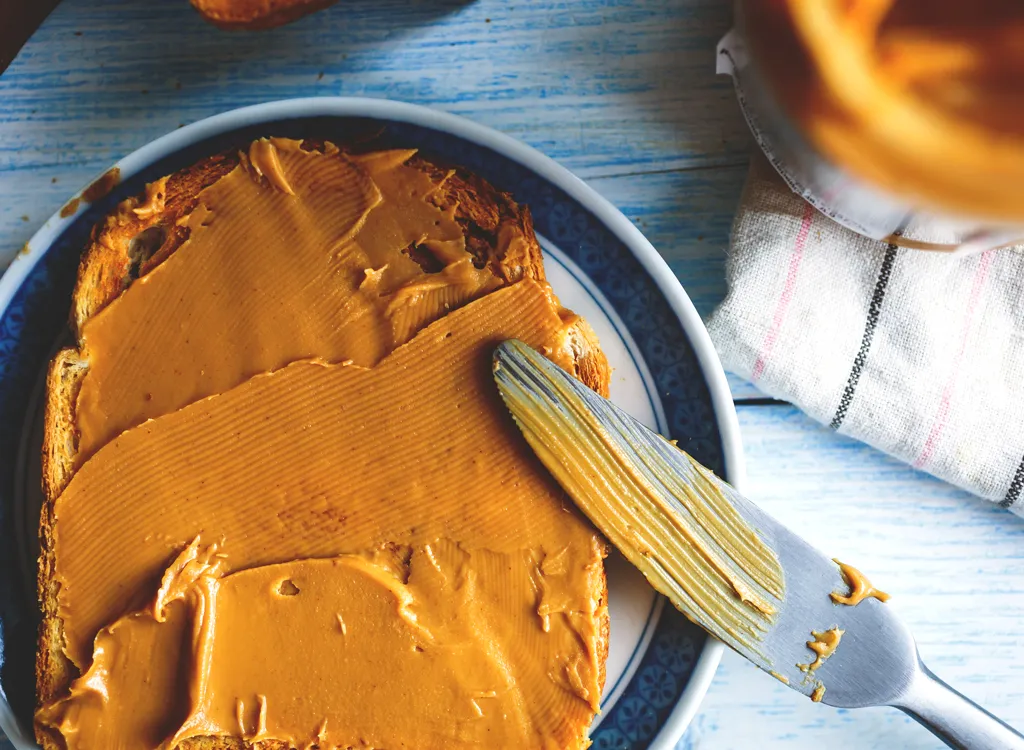
Prebiotics featured: almonds, walnuts
If you love a good smear of nut butter, your healthy and lean gut is in luck. Research has found that nuts help good bacteria to thrive and other research suggests that nuts' prebiotic benefits may aid in weight management, which isn't so nuts when you consider how high they are in fiber and phenolic compounds. Most research seems to be conducted on walnuts, almonds and pistachios, but all nuts seem to provide benefits.
Creative ways to reap the prebiotic benefits of nuts include:
- Add walnuts to your smoothie. A Journal of Nutrition study found that eating about one-half cup of walnuts daily for three weeks increased inflammation-reducing, butyrate-producing gut bacteria.
- Add almond butter to oatmeal
- Make a PB&J
- Use any nut butter in cookies like this one
- Make a fruit and veggie dip by mixing a half cup each of nut butter and yogurt, adding a dash or two of honey and vanilla extract
Disclaimer: The Nutrition Twins are sponsored by Bob's Red Mill, Pacific Foods, and KIND Snacks. All thoughts and opinions are their own.
